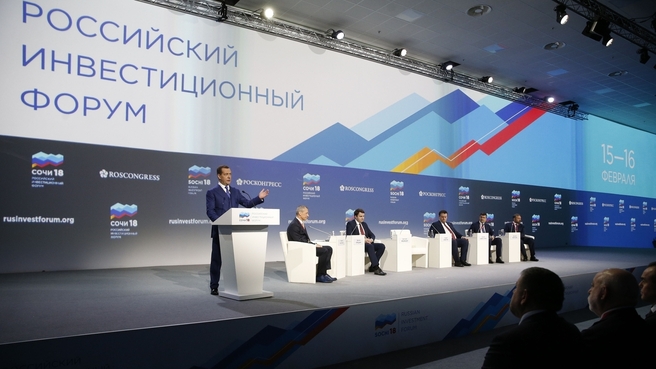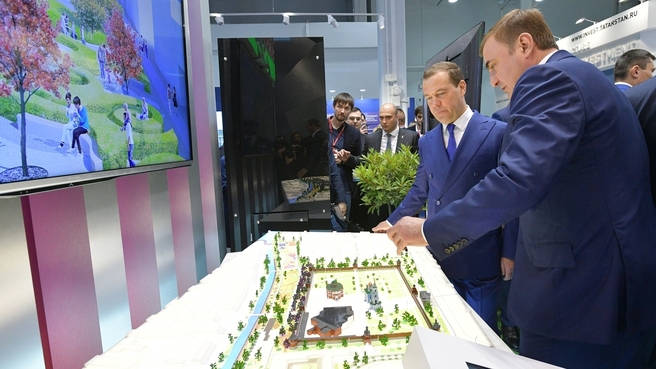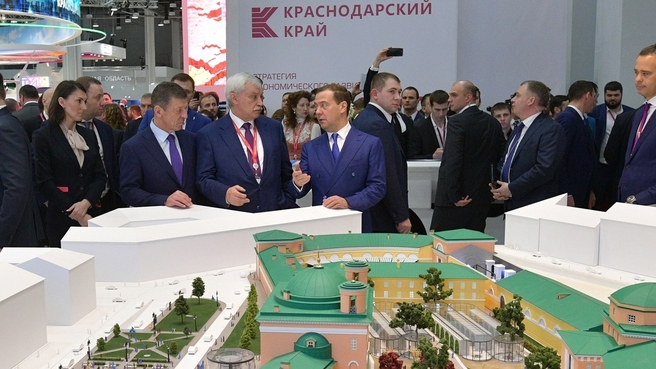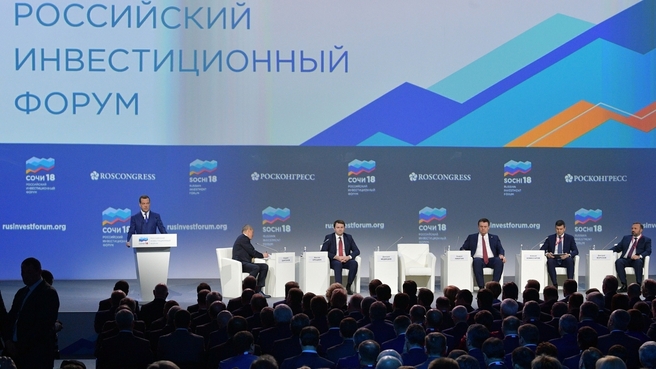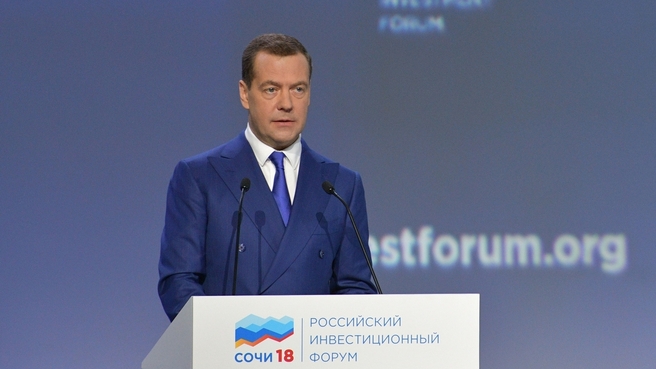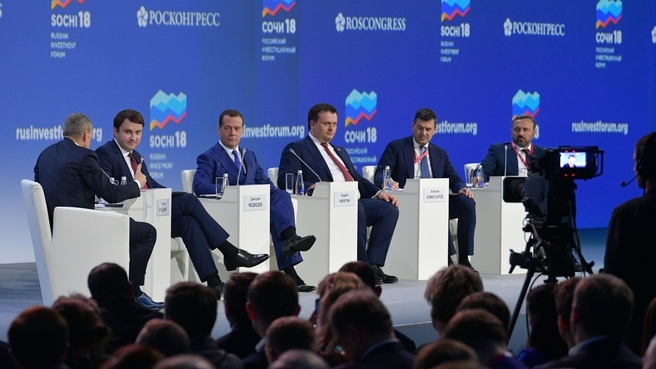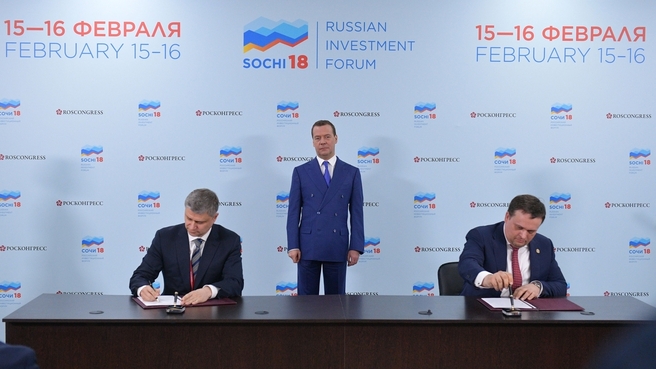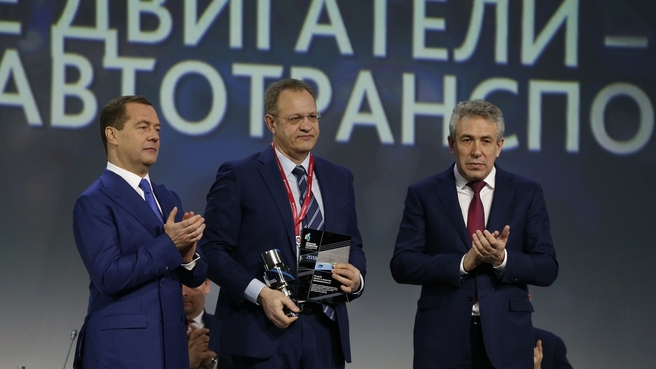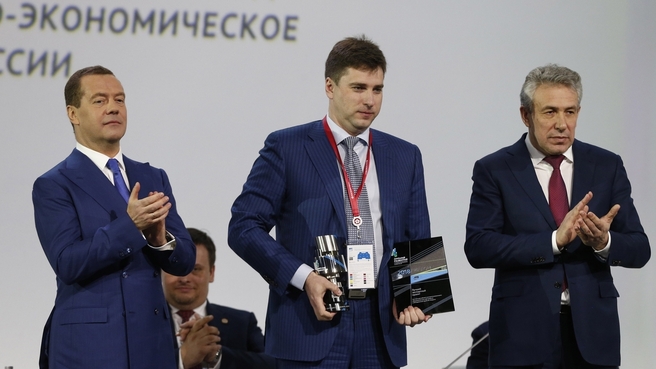Plenary session Investing in the Regions, Investing in the Future.
Plenary session Investing in the Regions, Investing in the Future
The main theme of the forum this year is Forming the Image of the Future. The programme comprises three blocks: New Regional Policy: Improving Administration, A Fresh Boost for Regional Business, and Improving the Quality of Life.
The Russian Investment Forum exhibition includes promising investment projects from the regions and companies.
From Dmitry Medvedev’s speech:
Last year, we had a revival of investment activity and the economic situation as a whole.
It is important that the inflow of investments was high enough to promote an emergence of new industries, in addition to support the work of conventional ones. To build a strong and healthy economy, our focus should be on making its structure as diverse as possible.
We have ensured macroeconomic stability. Even under the sanctions, our economy has become less vulnerable to external shocks and commodity prices. We brought inflation down to a record low of 2.5 percent last year. By the end of January, it fell to 2.2 percent compared with January 2017. In 2015, it was five times higher, 13 percent.
We have a stable financial system and the national currency exchange rate, as well as a balanced federal budget – this year we even may show a surplus. We are starting to add funds to our sovereign fund. GDP showed an upward trend, including through targeted support of industries. We have had an all-time record grain harvest.
We must concentrate our efforts primarily on creating stable and predictable rules for businesses, ensuring investment growth, and further improving the business climate.
Above all, it is imperative to increase investment in human resources. We need high-tech medicine, modern world-level education, and investment in infrastructure, specifically, new high-quality roads, bridges, power grids, and engineering systems which form the framework for the muscles of the economy which are modern manufacturing facilities.
Budgetary funds alone are not enough to get the economy going; it is necessary to encourage commercial investment and to create the proper conditions to draw investors.
Above all, investors need a predictable business environment, which is ensured by a stable taxation system that should help businesses grow, and low inflation that shouldn’t go beyond certain parameters. We talked about 4 percent, but now it's even lower. Add to that a transparent and predictable tariff policy.
The state should not subject businesses to unfair and excessive competition. There’s no reason to support the creation of similar manufacturing facilities in neighbouring regions unless there is actual demand for output. This implies the need for better planning investment strategies for each region and coordinating them with other regions.
Investors are also interested in the infrastructure. Low investment activity can often be ascribed to substandard infrastructure.
We are getting ready to launch an infrastructural mortgage programme. It will allow the state to invest in infrastructure with loan installments. As a result, the same level of investment will allow us to start building more sites.
Cheap long money is critical. Consistent efforts are underway to reduce lending rates, primarily through the effective use of inflation targeting. Last week, the Central Bank again lowered the key annual rate to 7.5 percent and is ready to create more favourable conditions for banks that issue manufacturing development loans.
We are creating innovative long-term investment tools. Today I signed a resolution to approve the Project Finance Factory programme, as well as rules for granting subsidies to VEB for carrying out credit transactions under this factory arrangement. Today, we will also sign key agreements on cooperation between Vnesheconombank and commercial banks, as well as on organising financing with project originators. We will start out with six projects. The total investment will reach about 180 billion roubles, most of which is private funds.
In 2017, we issued 670 billion roubles in loans under all incentive loan programmes. This ultimately resulted in a 3 percent reduction in loan interest on the market. This year we have launched a revised programme, under which the investment loan rate will be 6.5 percent and the largest possible loan is 1 billion roubles. We have selected 15 banks for this programme.
A positive example of long-term investment instruments is the issuance of federal loan bonds (OFZ) for individuals. We started selling them last spring. The first batch sold out very quickly. Overall, individuals have bought some 30 billion roubles’ worth of federal loan bonds. I would like to ask the Finance Ministry to analyse the possibility of increasing the emission of OFZ for individuals to 100 billion roubles in 2018. I believe this practice should also be used at the regional level so that the constituent entities are interested in issuing their own securities for individuals.
We have been working hard for the past few years to improve the conditions for doing business in Russia. We continued to improve our ranking on the Doing Business Index, rising from 124th place in 2011 to 35th in 2017. We have reached a level that is comparable to that of the world’s largest economies.
Over the past few years, we have gained considerable experience in digitalising relations between the state and the citizens. We must now digitalise the relations between business and the state, primarily in the sectors where officials might be tempted to use their authority for personal gain.
The widespread installation of online cash registers has created conditions for seriously reducing, and in some cases, eliminating tax reporting by some groups of small and medium-sized companies.
We need to start developing a national data management system at the Federal State Statistics Service (Rosstat). In this context, the Economic Development Ministry should prepare a priority Government project on this issue as soon as possible.
The State Duma is considering a bill that will bring order to all types of government control. It is necessary to develop a smart control system. Oversight bodies are already required to publicise their requirements for inspections. There is a unified inspection registry. Efficiency of government control is not measured by fines or sanctions but by the efforts taken to prevent violations.
Every city and every region can create new opportunities. It is necessary to find the key to progress. This key could be a potentially successful industry or a competitive advantage. The Spatial Development Strategy until 2025 must help with this. The strategy will be finished this year. It is to produce the very infrastructure framework we need.
In addition to major projects, we must map out the numerous areas for small and medium-sized businesses to apply their capacities. This will allow us to create as many smaller-scale centres as possible in addition to global competition centres (big cities and metropolitan areas). Smaller cities and towns must determine one or two niches where they can compete, and focus on them.
Our primary goal is to create an environment where regional and local authorities can independently address issues in their own economic and social spheres. This is included in the Regional Policy Guidelines approved by the President. A number of recent decisions in the area of inter-budgetary relations were made with that goal in mind. Total intergovernmental transfers will exceed 1.7 trillion roubles this year, which is approximately 2.5 percent more than last year.
State support is now based strictly on regional leaders’ achievements. To be eligible for this support, the regional authorities must commit to grow their economy and rehabilitate their finances, and be accountable for honouring their commitments. We need to support the regions’ independence in every possible way and give them more freedom.
Grants for achieving the highest growth rates have been allocated since last year. This year, corporate revenue tax growth (about 36 billion roubles) is being returned to regional budgets.
Our regional policy seeks to make people want to live in their area, so they don’t want to leave in search of a better life. The social well-being of people is the hallmark of a strong economy.
We will engage in all these social areas relying on the experience that we gained during the implementation of the May 2012 presidential executive orders and the improvements that we have already achieved.
We – all of us – are working to make sure our country’s economy grows so that the successes of the regions can be felt not just in the regions, but throughout the country, and perhaps even internationally. Together, we are building such a Russia. There is no doubt that we will accomplish this.
